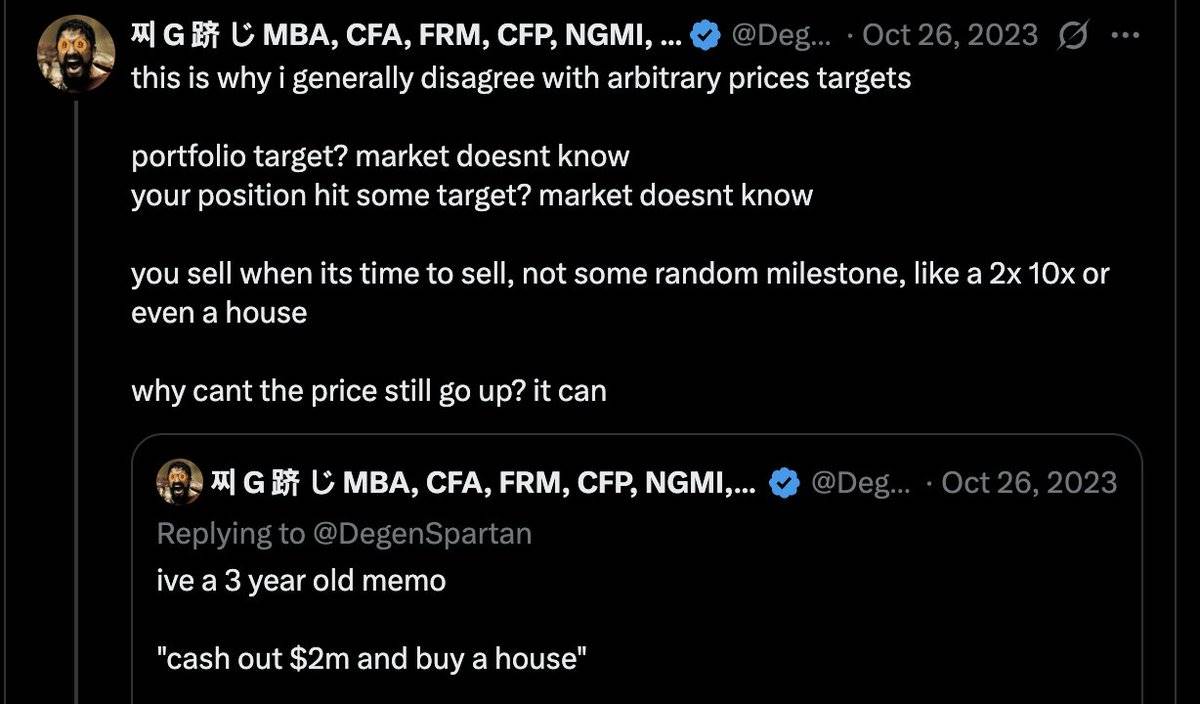The feeling after losing all positions in three months: Escape from the top is like a difficult time, and you should set up a target point to sell

Reprinted from panewslab
03/15/2025·1MAuthor: Res
Compiled by: Deep Tide TechFLOW
I have been reflecting on a question after losing most of my portfolio over the past three months:
“Sell when your portfolio reaches its target, and don’t drag it until you think the market has peaked.”
I have always believed that selling based on personal goals is counterproductive because your trading risks and behavior should be determined by the market. By the way, you can see @DegenSpartan's post, who defends this view.

If I achieved my goal when Bitcoin (BTC) hit $50,000, why would I sell it without thinking it could rise to $100,000? This doesn't make sense to me.
Similarly, if your portfolio has reached $870,000 and your target is $1 million, you won't force the market to continue to rise because the target is $1 million, especially if the market may have peaked.
You have to accept reality and let it go.
However, this mentality is too idealistic, or only those 0.01% of people can do it. Yes, this method is perfect, but the reality is that you cannot accurately grasp the pinnacle of the market.
How many people have experienced capital declines from their highs? I bet there are a lot of people here who have reached the financial freedom they dream of months or even years ago, watching the wealth evaporate in a few weeks.
Bad liquidity junk coins, retaliatory trading, leverage operations... Some people even fell from eight-digit assets to nothing.
You can never know if the market has peaked because you don’t have that ability.
The reason why you make a lot of money is often the reason why you lose everything - most of the time you are a "perma-bull", and your high risk tolerance brings huge returns when the market is good, but this behavior pattern and the positive feedback from continuous victory will make you lose your mind when the market is bad and eventually be "harvested".
Not to mention the timing of the market: The bottom usually takes several months to form, while the top often appears suddenly within a few days, especially after an exponential rise.
Except for those very few excellent traders, most people will still be bullish when they should sell, because this is how they trade.
And when they make mistakes, especially when they make big mistakes, some people can't even bear it. If you have reached your goal, why not "save the game progress" and start over from a calm, abundant and objective state? It's like playing a video game - you won't save progress without saving your progress in a one-time pass.
When you lose a lot, you will realize that what you once had is more real and more valuable than the numbers on the screen.
On the other hand, I don't think those who hold the mentality of "I will stop when I get to a certain point" can succeed. This mentality will never bring you closer to your goal, because you have to love this game: Learn > Improve > Win. Money is just a measure of your progress, but that doesn't mean you can "save progress" when you reach your goal.
Sometimes, more benefits don’t change much in your life, but the risks you take are high. You are always tempted to think that now is the time to bet fully, and you always have reason to be bullish on the market.
The vast majority of people who trade in these markets should adopt a systematic approach to profit and risk management:
1. Avoid "full warehouse" behavior. Accept reality, you are not that top trader. Maybe one day it will be, but not yet.
2. While making profits, you must gradually withdraw funds no matter what your view of the market.
3. Set larger goals based on lifestyle and clarify the risk-to-reward ratio (R:R). When your net worth reaches a certain level, you should start reducing the risk, as further gains may not significantly change your life, but losses can have a huge impact.
For example, rising from $500,000 to $900,000 may not change your life, but the impact of falling from $500,000 to $100,000 is huge, although the net difference between the two is $400,000.
Take out more funds and reduce risk at the level you set. Your goal is to start from a full mindset, not be driven by fear and lack. You will be amazed at how objective you can become—suddenly, emotions no longer control you.
4. Manage risks based on market dynamics. In some cases, you can take risks more radically, such as the ETF approval, the Fed begins to cut interest rates, Trump’s victory, or the next time Trump, Powell or other key figures explicitly release a buy signal.
Your risk management and portfolio allocation should be a combination of 1) market basis and 2) personal life basis, rather than taking into account only one of the factors.
Most people only focus on market factors and ultimately cannot achieve their goals because this is not realistic for most people.
5. Love this game and focus on progress, and money will naturally follow. To succeed, you can never stop. If you want to stop, you will never succeed.

